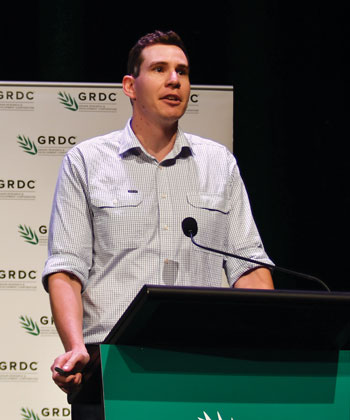Key points
- A three-year PhD research project explored the performance of short-season winter-sown wheats
- Short-season winter-sown wheats allow growers to sow when soil moisture is more reliable
- This research project is aimed at development of a short-season 100-day wheat
Trials have shown significant potential for the development of late-sown, short-season winter wheats to counter autumn conditions that are becoming warmer and drier.
Currently, there are no commercially available mid-winter-sown wheat options, so a three-year GRDC-supported project led by Charles Sturt University explored the performance of short-season, winter-sown wheats. The project was also supported by InterGrain, the New South Wales Department of Primary Industries (DPI) and CSIRO.
Project leader Tim Green, a GRDC-supported PhD student, says that with rain in autumn becoming less reliable, a winter-sown wheat would allow growers to delay sowing until there is more certainty about the availability of adequate soil moisture and provide more options for weed control.
“With the development of 100-day wheats, or a faster wheat, we can open a new sowing window to when there is more-reliable moisture in the soil,” Mr Green says.
The trials took place over 2021 and 2022 at the NSW DPI Wagga Wagga site. Ninety-six cereal lines were sown in 2021, with a subset of 44 sown in 2022. In total, the trial explored three sowing times: 7 June 2021,
12 July 2021 and 28 June 2022.
Observations
 Tim Green presented the results of short-season winter-sown wheat research at the 2024 GRDC Updates. Photo: Claire Crawford
Tim Green presented the results of short-season winter-sown wheat research at the 2024 GRDC Updates. Photo: Claire Crawford
In the right conditions, elite early vigour cultivars sown in mid-winter have the potential to yield well, with the June sowing times achieving 5.16 tonnes per hectare in 2021 and 5.5t/ha in 2022, while July 2021 achieved 4.46t/ha. These pre-breeding cultivars were developed solely for their early vigour potential and yet some out-yielded current commercial varieties.
However, Mr Green says genotypes with the greatest early vigour and quickest flowering did not perform significantly better. This was put down to mild growing conditions during the pre and post-anthesis periods. Mr Green says it is still hypothesised that these qualities would have greater influence in a more typical, drier finishing season.
On average, each time-of-sowing flowered six days late, with the latest being 15 days after optimal flowering time. While no yield penalty was observed in these trials, it is possible that in seasons with greater temperature fluctuations this could affect yield. Mr Green notes that this is where a wheat tailored for later sowing with faster phenology/flowering, which is not currently commercially available, could become useful.
“This experiment has demonstrated the yield growth potential of elite early vigour wheat lines when sown mid-winter and the opportunities for their integration into future commercial wheat varieties,” he says.
He also notes that a short-season 100-day wheat could provide growers with flexibility in combating herbicide-tolerant weeds, as well as when double-cropping.
More information: Tim Green, tigreen@csu.edu.au

























































